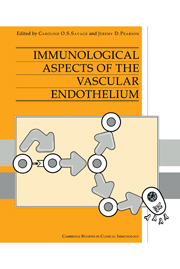Book contents
- Frontmatter
- Contents
- List of contributors
- Preface
- 1 New concepts of mechanisms in autoimmunity
- 2 Regulation of endothelial cell function by cytokines
- 3 Interactions between granulocytes and endothelium
- 4 The regulation of lymphocyte migration by vascular endothelium and its role in the immune response
- 5 Role of the vascular endothelium in immunologically mediated neurological diseases
- 6 The role of the endothelium in systemic lupus erythematosus and Sjögren's syndrome
- 7 The role of the endothelium in rheumatoid arthritis and scleroderma
- 8 The role of the endothelium in systemic vasculitis
- 9 Endothelial involvement in childhood Kawasaki disease
- 10 The role of the endothelium in thrombotic thrombocytopaenic purpura and haemolytic uraemic syndrome
- 11 The immunological role of the endothelium in organ transplantation
- Index
4 - The regulation of lymphocyte migration by vascular endothelium and its role in the immune response
Published online by Cambridge University Press: 04 August 2010
- Frontmatter
- Contents
- List of contributors
- Preface
- 1 New concepts of mechanisms in autoimmunity
- 2 Regulation of endothelial cell function by cytokines
- 3 Interactions between granulocytes and endothelium
- 4 The regulation of lymphocyte migration by vascular endothelium and its role in the immune response
- 5 Role of the vascular endothelium in immunologically mediated neurological diseases
- 6 The role of the endothelium in systemic lupus erythematosus and Sjögren's syndrome
- 7 The role of the endothelium in rheumatoid arthritis and scleroderma
- 8 The role of the endothelium in systemic vasculitis
- 9 Endothelial involvement in childhood Kawasaki disease
- 10 The role of the endothelium in thrombotic thrombocytopaenic purpura and haemolytic uraemic syndrome
- 11 The immunological role of the endothelium in organ transplantation
- Index
Summary
The immune response can be divided into several stages. The stimulation of naive lymphocytes by antigen is followed by the proliferation of lymphocytes and their differentiation into effector lymphocytes which eliminate antigen from infected tissues (cytotoxic cells, antibody or cytokine secreting cells), and memory cells, which enable the host to mount a secondary immune response. These distinct stages of the immune response are regulated by the ability of lymphocytes to migrate to different organs of the body. Lymphocytes enter most organs directly from the bloodstream and recent research has emphasized the crucial role that vascular endothelial cells (EC) play in sorting lymphocyte subpopulations for subsequent migration into tissues. Before discussing the molecular basis of interactions between lymphocytes and endothelial cells that regulate lymphocyte migration, I would like to consider the pivotal role that lymphocyte migration plays in the regulation of the immune response.
Lymphocyte migration and the regulation of the immune response
Immune responses are initiated when T lymphocytes contact antigenic peptides complexed with products of the major histocompatibility complex (MHC) on the surface of antigen presenting cells (APC). Engagement of the antigen receptor is not sufficient to elicit the full proliferative response of naive T lymphocytes and additional receptor-ligand interactions are required to co-stimulate T cells (Schwartz, 1992). The site of stimulation of naive lymphocytes is thought to be restricted to secondary lymphoid organs (lymph nodes and spleen) where specialized, dendritic APC express full costimulatory activity for T cells (Steinman, 1991).
- Type
- Chapter
- Information
- Immunological Aspects of the Vascular Endothelium , pp. 64 - 95Publisher: Cambridge University PressPrint publication year: 1995



